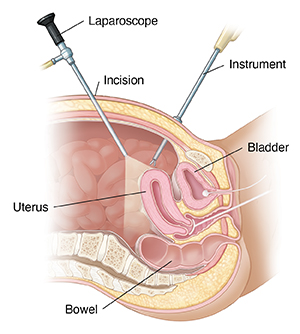Understanding Laparoscopic Hysterectomy
Having your uterus (womb) removed is called a hysterectomy. Using a method called laparoscopy has many benefits. You may spend less time in the hospital and recover faster.
What is hysterectomy?
Hysterectomy removes the uterus. Part or all of the uterus may be taken out. Certain other organs may be removed at the same time. Having your uterus removed means that you won’t be able to get pregnant in the future.
What is laparoscopy?
Laparoscopy is a type of surgery. A long, lighted tube with a camera is used. This is called a laparoscope. The scope sends pictures of the inside of the body to a video screen. For the surgery, a few small incisions are made in the belly (abdomen). The scope is inserted through one of the small incisions. Surgical tools are inserted through the other incisions to complete the procedure.

Benefits of laparoscopy
This procedure is done instead of open surgery. Open surgery needs a larger incision in the abdomen. Compared to open surgery, laparoscopy may:
-
Need less time in the hospital or surgery center
-
Offer a faster recovery
-
Cause less internal scarring and smaller visible scars
-
Cause less pain after surgery
-
Have a lower risk of complications
Risks and possible complications of laparoscopic hysterectomy
-
Side effects from anesthesia
-
Infection
-
Bleeding, with a possible need for a transfusion
-
Blood clots
-
Damage to the bladder, bowel, ureters, or nearby nerves
-
Hernia
-
Formation of scar tissue that can cause pain or bowel obstruction often times years later
-
Need for a second surgery
© 2000-2025 The StayWell Company, LLC. All rights reserved. This information is not intended as a substitute for professional medical care. Always follow your healthcare professional's instructions.